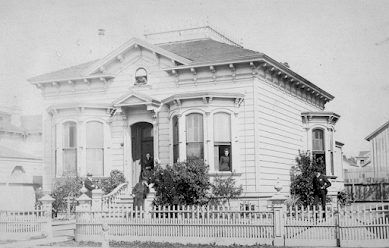 |
| Dick Apgar's Obituary and Grave Marker |
Plot 24, Lot 12
Dick Apgar was an American Civil War officer, lawman, and civic figure active in both San Francisco and Oakland, California. Known for his colorful personality and broad involvement in public service and politics, Apgar’s life spanned frontier migration, military service, and the turbulent political scene of post-Gold Rush California.
Born in Montgomery County, Ohio, in April 1836 to Jacob and Hannah Apgar—both of New Jersey origin—Apgar journeyed westward as a teenager. At the age of 16, he joined a wagon train bound for California, arriving in 1854 and initially trying his fortune in the goldfields before settling in Solano County.
During the Civil War, Apgar was commissioned as a First Lieutenant in Company F of the 7th California Infantry Regiment at the Presidio of San Francisco on November 30, 1864. He was stationed at Fort McDowell in the Arizona Territory before mustering out with his unit on April 13, 1866, also at the Presidio. After the war, he returned to Solano County and married Lois Marie Marston in Suisun, California, on July 4, 1869.
 |
| Fort McDowell in the Arizona Territory |
Apgar embarked on a career in law enforcement and public service. In 1871, he was elected Sheriff of Solano County. Following his term, he served for four years as a turnkey at San Quentin State Prison. He later moved to San Francisco, where he became deeply involved in local politics. He lobbied the State Legislature in Sacramento and played a key role in the establishment of Police Court No. 2, serving for several years as its bailiff. He was appointed doorkeeper of the California State Assembly during the 1881–82 legislative session.
In the early 1880s, Apgar relocated to Oakland, where he was admitted to the bar, though he did not practice law. He ran unsuccessfully as the Republican nominee for the State Assembly from the 53rd District in 1884. At the time of his death, he was described as a wealthy man, having made astute investments in land and stocks, with his estate estimated at $100,000—a considerable sum for the time.
Apgar was deeply involved in fraternal and veterans’ organizations, including the Freemasons and the Grand Army of the Republic. He was a member of Mount Moriah Lodge in San Francisco, and his funeral was conducted with Masonic honors in Oakland by Live Oak Lodge. Members of Lincoln Post No. 1 and delegations from other Grand Army posts were in attendance.
Richard M. Apgar died suddenly on December 21, 1887, in Oakland due to heart failure. He was 51 years old. His widow, Lois, survived him until her death in 1903 and received a widow’s pension under the 1890 federal pension act.

The land where he resided in Oakland is known as the Apgar Tract and a street still bears his name. The Apgar Tract is a historic residential subdivision situated in the Longfellow neighborhood of North Oakland. It encompasses the area around Apgar Street, which runs between Market Street and San Pablo Avenue. The tract was developed during a period of significant growth in Oakland, as the city expanded to accommodate a burgeoning population and increased demand for housing. Today, the Apgar Tract is characterized by a mix of residential properties, including single-family homes and multi-unit buildings. Many of these structures date back to the early 20th century, reflecting the architectural styles prevalent during that era. The neighborhood's proximity to transportation hubs, such as the MacArthur BART station, and its location near major thoroughfares have made it an attractive area for residents seeking convenient access to the broader Bay Area.





















